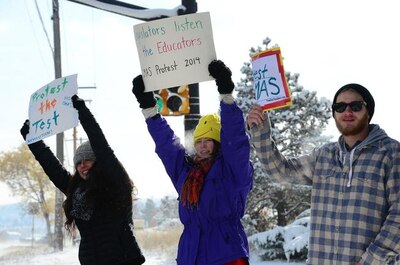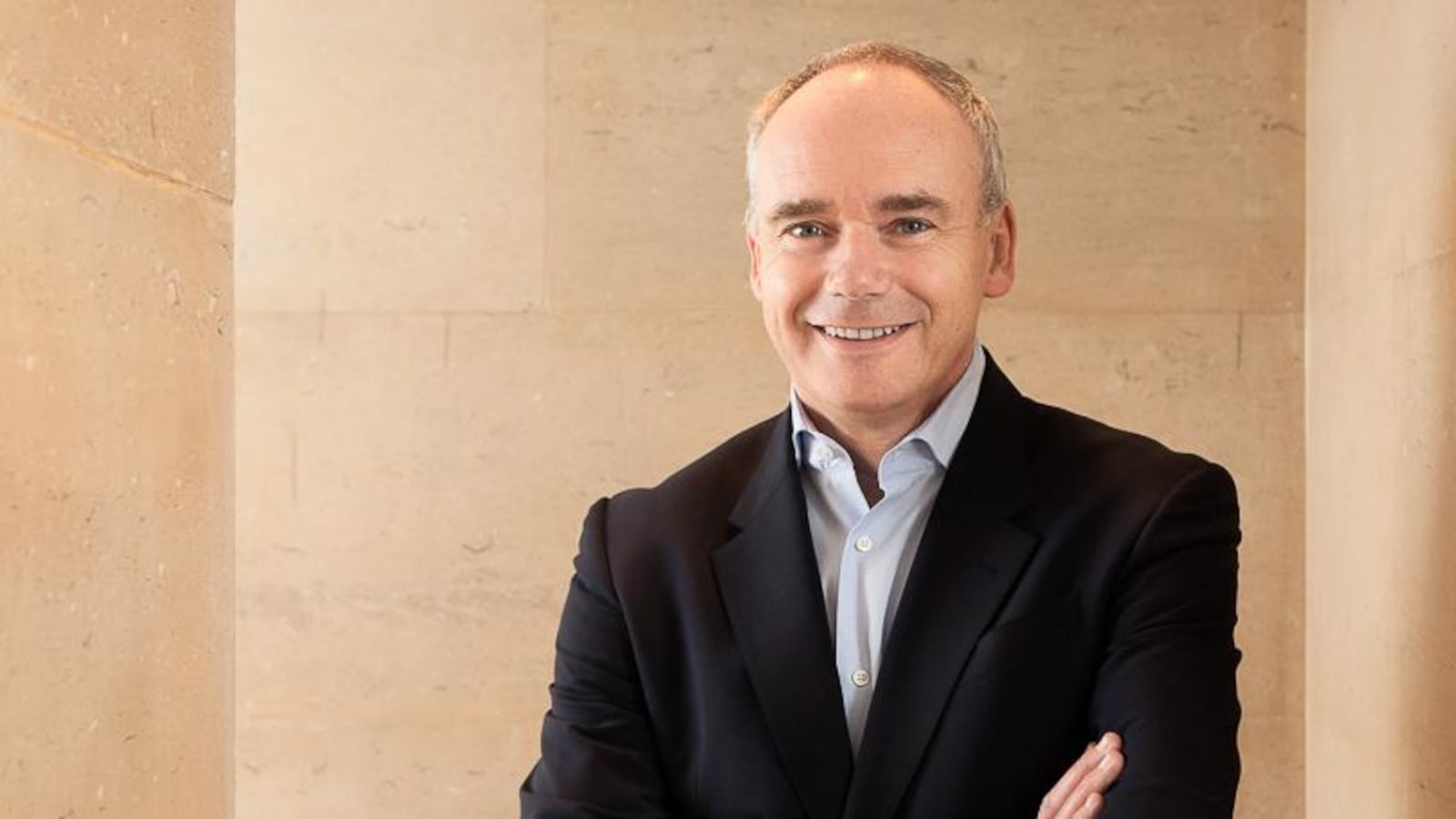When it comes to this country’s greatest debates about public education — standards, testing, technology — Pearson is in the middle of it all.
The British company is the world’s largest textbook publisher, a testing giant, and increasingly a player in digital curriculum. Established in 1844, Pearson has cemented itself as the leading education company in the 21st century while drawing plenty of criticism from parents, teachers, and some lawmakers along the way.
One charge against Pearson, which makes about 60 percent of its profits in the U.S., is its outsized influence over state and federal lawmakers on education policy. Critics claim Pearson’s wealth — it made about $6 billion in revenue last year — too often goes unmatched.
While in Colorado last week, Pearson CEO John Fallon spoke to Chalkbeat to respond to that claim, opine on Colorado’s sweeping data privacy law that some call a national model, and discuss the increasing role technology is playing in public education.
This interview has been edited for brevity and clarity.
You’re in Colorado for the Aspen Ideas Festival, billed as one of the largest gatherings of business and civic leaders and researchers. What are you taking away?
I think the real sort of understanding from talking with other CEOs from the country’s largest companies is that we have a responsibility to help and support writing education standards, that we should be concerned that inequality in educational opportunity is contributing to inequality in income and life chances, and we all have to do a lot more work for everyone — especially those from disadvantaged backgrounds — to make the transition from high school to college and career easier.
In particular, we have to make high school more relevant, with clear pathways through.
And all great companies must have a wider purpose that really drives them.
Colorado recently passed one of the most if not the most sweeping student data privacy protection bills in the United States. The bill was so popular, it didn’t receive a single no-vote.
The main elements of the bill include a detailed definition of personally identifiable information that must be protected, restrictions on software companies and other vendors, and additional transparency and disclosure requirements for the Colorado Department of Education and school districts. The bill also sets some district controls over classroom apps and software used by teachers.
What does this kind of legislation mean to Pearson, one of the world’s largest collectors of student data?
I think as you know, this is a responsibility we take very seriously. All the data we hold on students, in one form or another, we take the view that that data belongs to our customers, which are schools, school districts, state boards of education and the like. We never would try to use or market or sell that data for commercial purposes whatsoever. And in every contract that we have with our customers, we take great care to be aligned with their expectations around data security and privacy.
School leaders in Colorado, from rural school districts to our former education commissioner, and lawmakers have made it clear they want to be a part of the federal testing and accountability pilot created under the Every Student Succeeds Act. What would it mean to Pearson if Colorado became the latest state to drop out of the PARCC consortium and/or scaled back its involvement significantly?
We respect the right of every state to decide what is appropriate for its schools, its students. We are firm believers that there is a role for assessment. But an end-of-year assessment should always only be one measure that is part of a more holistic view.
We are firmly in the belief that we should be moving to fewer, smarter, and better assessments.
We’re working with our customers to achieve that. You can see that in how the PARCC itself is evolving. Clearly, at the end of the day, it’s for the elected policymakers at the state level to define their policy and what they want to do. If asked to do so, we do our best to help implement those policies.
Do you think that the number of states that have dropped out of PARCC has signaled there was an inherent flaw in the test or the consortia?

There’s obviously been a wide debate about the role of high-stakes tests, how frequent they should be, and how they should be used for teacher accountability and the like.
Every state needs to make its own decision. We do think there is a role for assessment in providing parents, teachers, students and policymakers with a confidence that things are on track — and if not, the warning that they need to innovate.
One of the things I’m really excited about — a major area of work for Pearson — is really a convergence of formative and summative assessments. So, at the same time you can use assessments for actionable feedback for teachers, parents and students while collecting enough data that gives policymakers and school superintendents an idea of what’s happening across the state.
It will take five to 10 years to get there, but it’s something we’re very focused on. It will go a long way to fulfill the need of assessments [for accountability] but addresses some of the concerns as well.
In a recent interview with Forbes, you told reporter Maureen Sullivan regarding standardized testing in the United States: “It’s a matter for elected representatives. We are the least of your concerns.”
But Pearson’s lobbying, sales and marketing influence has been well documented — especially in a 2015 Politico investigation that found: “Pearson has aggressive lobbyists, top-notch marketing and a highly skilled sales team. Until the New York attorney general cracked down in late 2013, Pearson’s charitable foundation made a practice of treating school officials from across the nation to trips abroad, to conferences where the only education company represented was Pearson.”
It goes on to showcase how you’ve landed exclusive long-term contracts at the state and federal level. And you’ve spent upwards of $1 million annually on lobbying.
Is it reasonable to expect that an urban education activist or a suburban mom can compete with Pearson’s influence?
I think that, as I say, every state and every policymaker will make policy and then they may or may not invite us to help implement that policy. Our views are well known. As we say, we believe in fewer, smarter, better assessments. Certainly, since I became CEO at the start of 2013, we are very open and transparent about how we engage with people.
I think that if you’re going to draw on the Politico report, there are very, very serious flaws in the reporting there. [Pearson has developed this document on its website in part to refute claims in the Politico article. Politico stands by its findings.]
We engage with policymakers. We engage with teachers unions and their representatives every day. Every single person who works at Pearson is deeply committed to education. Our focus and purpose is in helping people, to empower people, to spend their lives learning. We operate with very, very high standards of integrity.
I’m very proud of everyone who works at Pearson and the work they do every day. You will not find a single person who works at Pearson who doesn’t start by saying, ‘What do we think is honestly the best thing to do for education? What can we do to support teachers and students and parents?’ That’s what we engage in as a company.
So why do you think Pearson gets such a bad rap?

We do regular tracking and surveys of perceptions of parents, teachers, college professors, policymakers, and again, that does not support the statement you just made.
I think if you talk to anyone at Pearson, you will find that there is a huge respect for the teacher. We spend our lives understanding the issues teachers face and those issues from their point of view. Our complete and absolute focus is helping people be successful in their life through learning. I think it is the most important work and mission any company can have.
Here’s a question from a Colorado mother: Outside of Pearson’s day-to-day business operations, developing and selling curriculum and tests, what role should the company play in improving schools and the conditions that surround schools — for example poverty, mental health — in the United States?
That’s a very good question. One of the things I’ve been spending time on during the last few days in Aspen is understanding the wider context of the challenges facing public schools in Colorado and Denver, in particular, and how we can help.
I think there is an interesting phenomena here in Denver that you see in other American cities, where as a major employer in Denver ourselves, it’s a very attractive city to graduates from around the county. And that’s contributing to the economic wealth of the city. But the danger is that the young native talent is not sharing in that economic prosperity.
There’s a lot of complex issues that no one company can resolve on its own. But we have a responsibility, and we play our part. As an example, we are working very actively with America’s Promise, investing and supporting different initiatives to see how we can help improve high school graduation rates. We’re very focused on supporting professional development of teachers. We’re actively involved in helping young people from disadvantaged backgrounds in getting to university and being successful there.
Just in the same way we’re working with Save The Children in Syrian refugee camps in Jordan. We’re also helping to convene 200 organizations around Project Literacy to focus on the 760 million people in the world today who cannot read or write.
We are just one company. But we have a wider responsibility. And it’s one we need to take seriously, and we do.
Blended learning, a mix of direct instruction and online courses, is undoubtedly the rage right now. Pearson is continuing to invest in digital offerings at both the K-12 and college level. But some new research shows that more technology in the classroom isn’t such a good thing. And some educators I’ve spoken to worry about too much screen time.
If you spend any time in any successful school — and it’s true in any city or state in America, or any country in the world — the common characteristics of that school will be: really strong leadership, not just from the school principal, but all of the teaching faculty; very strong teachers who work as a team, who engage and support children and are actively talking about their students; and you’ll find very high expectations for every student in the school; and a personal plan for each student.
I think the role of technology is to help those things to happen at greater scale and with more efficacy: To help teachers to be more effective and engaging in their own work and culture, providing a way to engage students on their own terms and own way, providing much more immediate and persuasive diagnostics and supports.
So, I guess what I’m saying is technology is all about enabling teachers to be better teachers. Technology is not a panacea. It cannot replace teaching.

